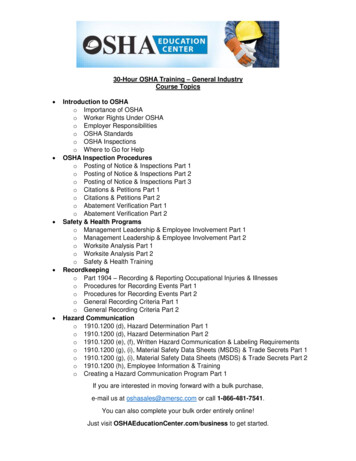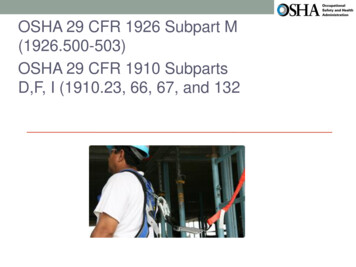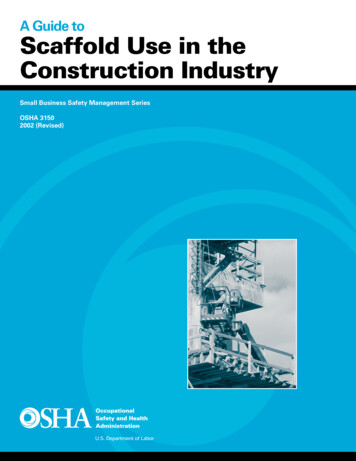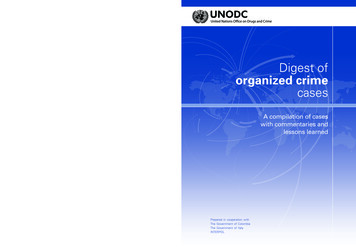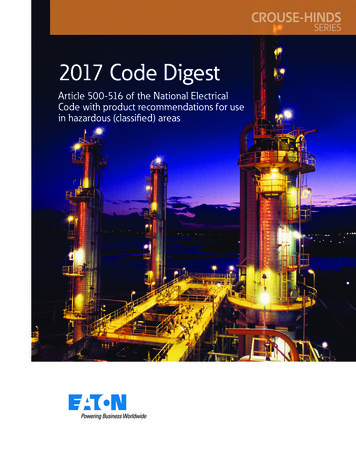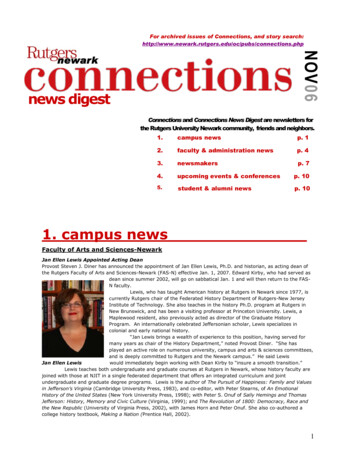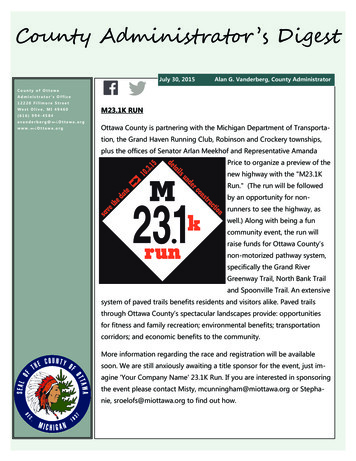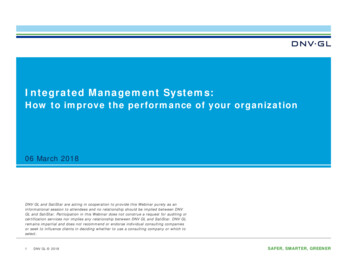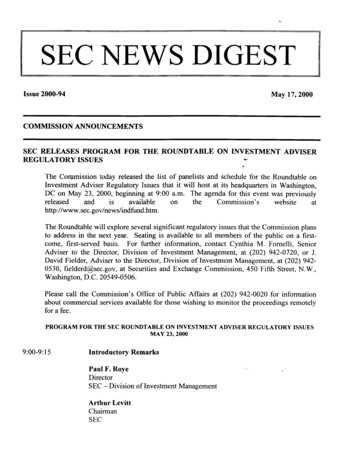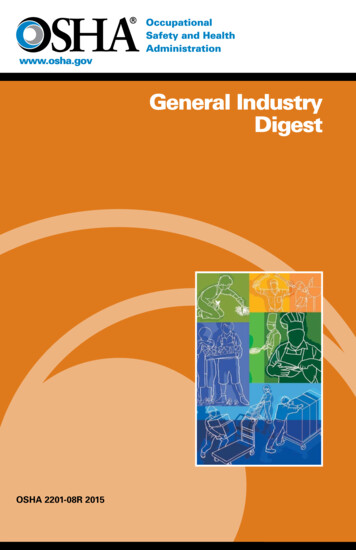
Transcription
General IndustryDigestOSHA 2201-08R 2015
Occupational Safety and Health Act of 1970“To assure safe and healthful workingconditions for working men and women; byauthorizing enforcement of the standardsdeveloped under the Act; by assisting andencouraging the states in their efforts toassure safe and healthful working conditions;by providing for research, information,education, and training in the field ofoccupational safety and health.”This publication provides a general overviewof standards-related topics. This publicationdoes not alter or determine complianceresponsibilities which are set forth in OSHAstandards, and the Occupational Safety andHealth Act. Moreover, because interpretationsand enforcement policy may change overtime, for additional guidance on OSHAcompliance requirements, the reader shouldconsult current administrative interpretationsand decisions by the Occupational Safety andHealth Review Commission and the courts.Material contained in this publication is in thepublic domain and may be reproduced, fullyor partially, without permission. Source creditis requested but not required.This information will be made available tosensory-impaired individuals upon request.Voice phone: (202) 693-1999; teletypewriter(TTY) number: 1-877-889-5627.
General IndustryDigestU.S. Department of LaborOccupational Safety and Health AdministrationOSHA 2201-08R2015
ForewordThe summary of General Industry safety and health standardscontained in this booklet are to aid employers, supervisors,workers, health and safety committee members, and safety andhealth personnel in their efforts toward achieving compliance withOSHA standards in the workplace.Although this digest does not contain a summary of all the GeneralIndustry safety and health standards, the ones presented here arethe standards most frequently cited, and which cover particularlyhazardous situations. The standards are grouped by subject matter,followed by the reference to the appropriate standard. With fewexceptions, the standards in this digest are from Title 29 of the Codeof Federal Regulations (CFR), Part DVPPAmerican National Standards InstituteAmerican Society of Mechanical EngineersSafety Data Sheetsparts per billionparts per millionPersonal Protective EquipmentPermissible Exposure LimitSeparate Engineering Control Air LimitShort-term Exposure LimitTime-weighted AverageTreatment, Storage, and DisposalVoluntary Protection ProgramsThis booklet is only a digest of basic applicable standards. It should in noway be considered a substitute for any provisions of the OccupationalSafety and Health Act of 1970, or for any standards promulgated underthe Act. The requirements contained herein have been summarized andare abbreviated. The appropriate source standards are noted at the endof each paragraph; the CFR should be consulted for a more completeexplanation of the specific standards listed.4 OCCUPATIONAL SAFETY AND HEALTH ADMINISTRATION
ContentsInjury and Illness Prevention Programs10Top 10 Most Frequently Cited Standards13General Industry Standards14General Duty Clause(Pub. Law 91-596 Section 5(a)(1))14Fatality, Injury and Illness Information14Recording and Reporting Occupational Fatalities,Injuries and IllnessesWalking-Working Surfaces1415Aisles and PassagewaysDockboardsFloors, General ConditionsFloor Loading LimitGuarding Openings and HolesHousekeepingFixed LaddersPortable LaddersRailingsToeboardsScaffoldsSkylightsFixed Industrial StairsMeans of Egress1515161616171718191920202121Emergency Action PlansExitsOccupational Health and Environmental Controls212223Nonionizing Radiation (Electromagnetic Radiation)Noise ExposureLocal/Exhaust VentilationSanitationChange RoomsDrinking Water232325262626GENERAL INDUSTRY DIGEST 5
Eating and Drinking AreasShowersToiletsConfined SpacesPermit-Required Confined SpacesControl of Hazardous Energy (Lockout/Tagout)Hazardous Materials27272728282931Compressed Gas CylindersOxygen-fueled GasAcetyleneCompressed GasesHydrogenNitrous OxideOxygenDip Tanks Containing Flammable or Combustible LiquidExplosives and Blasting AgentsFlammable LiquidsContainers and Portable Tank StorageBoilersPressure Vessels (Boilers)Hazardous Waste Operations and Emergency ResponseProcess Safety Management of Highly Hazardous ChemicalsSpray-Finishing OperationsHazardous Agents3131313131323232333334353536384041Air ContaminantsAsbestosBloodborne PathogensBenzene1,3-ButadieneCadmiumChromium (VI)Ethylene OxideFormaldehydeLead6 OCCUPATIONAL SAFETY AND HEALTH ADMINISTRATION41424345464849515254
Methylene ChlorideMethylenedianilineHazard CommunicationExposure to Hazardous Chemicals in LaboratoriesIonizing RadiationDOT Markings, Placards and LabelsPersonal Protective Equipment56575961626363Eye and Face ProtectionEyewash/Drench ShowerFoot ProtectionHead ProtectionRespiratory ProtectionFall ProtectionMedical Services65656667676971Medical Records and Employee Exposure RecordsMedical Services and First AidWelding, Cutting and Brazing717172Welding General RequirementsWelding in Confined SpacesMaterials Handling and Storage727374Chains, Cables, Ropes and HooksCranes (Overhead and Mobile), Hoists and DerricksStorageHazardous Equipment and Machinery74757576Air ReceiversBelt Sanding MachinesUse of Compressed AirFan BladesForklift Trucks (Powered Industrial Trucks)Hand ToolsLockout/Tagout: Control of Hazardous EnergyMachine GuardingFixed Machinery767677777778297879GENERAL INDUSTRY DIGEST 7
Mechanical Power PressesPortable Power Tools (Pneumatic)Power Transmission Equipment GuardingPowered Platforms for Building MaintenancePortable Circular SawsWoodworking MachineryRestartsCircular Table SawsRip SawsInverted Swing or Sliding Cut-off SawsRadial SawsSelf-feed Circular SawsSwing or Sliding Cut-off SawsAbrasive BlastingAbrasive GrindingGrain Handling Facilities79818182838484848585858585868687Entry into Grain BinsControl of Grain Dust Fires and ExplosionsFilter CollectorsPreventive MaintenanceInside Bucket ElevatorsHot Work PermitEmergency Action PlansGeneral Electrical Safety8789898990909192Flexible Cords and Cables (Extension icationListing and LabelingElectrical OpeningsSafety-Related Work PracticesSplices8 OCCUPATIONAL SAFETY AND HEALTH ADMINISTRATION939393949494949495
Hazardous Workplace Complaints: Worker Rights96OSHA Assistance, Services and Programs97OSHA Advisory Committees100NIOSH Health Hazard Evaluation Program101OSHA Regional Offices102How to Contact OSHA105GENERAL INDUSTRY DIGEST 9
Injury and Illness Prevention ProgramsAn injury and illness prevention program,1 is a proactive process tohelp employers find and fix workplace hazards before workers arehurt. We know these programs can be effective at reducing injuries,illnesses, and fatalities. Many workplaces have already adoptedsuch approaches, for example as part of OSHA’s cooperativeprograms — such as the Voluntary Protection Programs. Not onlydo these employers experience dramatic decreases in workplaceinjuries, but they often report a transformed workplace culturethat can lead to higher productivity and quality, reduced turnover,reduced costs, and greater employee satisfaction.Based on the positive experience of employers with existingprograms, OSHA believes that injury and illness preventionprograms provide the foundation for breakthrough changes inthe way employers identify and control hazards, leading to asignificantly improved workplace health and safety environment.Adoption of an injury and illness prevention program will result inworkers suffering fewer injuries, illnesses and fatalities. In addition,employers will improve their compliance with existing regulations,and will experience many of the financial benefits of a safer andhealthier workplace cited in published studies and reports byindividual companies, including significant reductions in workers’compensation premiums.Thirty-four states and many nations around the world alreadyrequire or encourage employers to implement such programs. Thekey elements common to all of these programs are managementleadership, worker participation, hazard identification andassessment, hazard prevention and control, education and training,and program evaluation and improvement.The occupational safety and health community uses various names to describesystematic approaches to reducing injuries and illnesses in the workplace.Consensus and international standards use the term Occupational Health and SafetyManagement Systems; OSHA currently uses the term Injury and Illness PreventionPrograms and others use Safety and Health Programs to describe these types ofsystems. Regardless of the title, they all systematically address workplace safety andhealth hazards on an ongoing basis to reduce the extent and severity of work-relatedinjuries and illnesses.110 OCCUPATIONAL SAFETY AND HEALTH ADMINISTRATION
Most successful injury and illness prevention programs includea similar set of commonsense elements that focus on findinghazards in the workplace and developing a plan for preventing andcontrolling those hazards. Each of these key elements are importantin ensuring the success of the overall program, and the elementsare interrelated and interdependent. In other words, they must beused together to create a system of prevention and control. Theelements recommended by OSHA are: Management Leadership: Management demonstrates theircommitment to improve safety and health, establishes goals andobjectives, and provides adequate resources and support. Employee Participation: Management actively involvesemployees in the program — for example, identifying andreporting hazards and investigating incidents. Employees areencouraged to communicate openly with management andreport safety and health concerns. Hazard Identification and Assessment: Processes andprocedures are put in place to continually identify and assessworkplace hazards and evaluate risks. Hazard Prevention and Control: Processes and procedures arecreated and implemented to control workplace hazards. Education and Training: All workers are provided with educationor training to carry out their part under the program. In addition,all workers are trained in a language and manner they canunderstand to recognize workplace hazards and trained in thecontrol measures needed to protect themselves and otherworkers from these hazards. Program Evaluation and Improvement: Processes are establishedto monitor the program performance, verify implementation,and identify deficiencies and opportunities for improvement.Employers take necessary actions to improve the program.Several government agencies and consensus standardsorganizations have guidance for injury and illness preventionprograms. OSHA issued voluntary safety and health programmanagement guidelines in 1989 that encourage the systematicidentification, evaluation, and prevention or control of generalworkplace hazards and the hazards of specific jobs and tasks.GENERAL INDUSTRY DIGEST 11
More recently, the American National Standards Institute (ANSI)issued ANSI Z10-2005, Occupational Health and Safety ManagementSystems. This voluntary consensus standard provides criticalmanagement system requirements and guidelines for improvementof occupational health and safety. The British Standards Institutionalso recently issued OHSAS 18001, an Occupational Health andSafety Assessment Series for health and safety managementsystems. OHSAS 18001 is an international occupational healthand safety management system specification intended to helporganizations control occupational health and safety risks.Further information on injury and illness prevention programs can befound on OSHA’s website at www.osha.gov/dsg/topics/safetyhealth.12 OCCUPATIONAL SAFETY AND HEALTH ADMINISTRATION
Top 10 Most Frequently Cited StandardsFederal OSHA maintains a list of the top 10 most frequently citedstandards following inspections of worksites to alert employers,so they can take steps to find and fix recognized hazards beforepreventable injuries and illnesses occur. For fiscal year 2014, themost frequently cited standards 2121910.303Fall Protection (Construction)Hazard Communication (p. 59)Scaffolding (Construction)Respiratory Protection (p. 67)Powered Industrial Trucks (p. 77)Lockout/Tagout (p. 29)Ladders (Construction)Electrical, Wiring Methods (p. 93)Machine Guarding (p. 78)Electrical, General Requirements (p. 92)For more information about commonly cited standards, visit:www.osha.gov/Top Ten Standards.html.More information about OSHA standards for Construction isavailable in the Construction Industry Digest, at www.osha.gov/Publications/osha2202.pdf.GENERAL INDUSTRY DIGEST 13
General Industry StandardsGeneral Duty Clause(Pub. Law 91-596 Section 5(a)(1))Hazardous conditions or practices not covered in an OSHAstandard may be covered under Section 5(a)(1) of the OccupationalSafety and Health Act (OSH Act), which states: “Each employermust furnish to each of his employees employment and a placeof employment which are free from recognized hazards that arecausing or are likely to cause death or serious physical harm to hisemployees.”Fatality, Injury and Illness InformationRecording and Reporting Occupational Fatalities,Injuries and IllnessesAs of January 1, 2015, employers must notify the OccupationalSafety and Health Administration (OSHA) within 8 hours of aworkplace fatality or within 24 hours of any work-related inpatienthospitalization, amputation or loss of an eye. This includes fatalitiesthat occur during work, as a result of a work-related heart attack.The report of such incidents must be given orally (via telephoneor in person) to the OSHA area office (or state plan office) that isnearest to the site of the incident (§1904.39(a)). Employers mayalso use OSHA’s toll-free telephon
Fixed Industrial Stairs 21 Means of Egress 21 Emergency Action Plans 21 Exits 22 Occupational Health and Environmental Controls 23 Nonionizing Radiation (Electromagnetic Radiation) 23 Noise Exposure 23 Local/Exhaust Ventilation 25 Sanitation 26 Change Rooms 26 Drinking Water 26. 6 OCCUPATIONAL SAFETY AND HEALTH ADMINISTRATION Eating and Drinking Areas 27 Showers 27 Toilets 27
